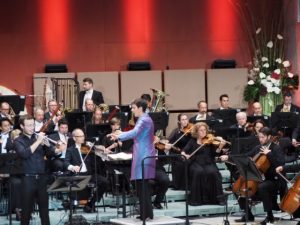Ypsilon, A Poem for Trumpet and Orchestra in Five Scenes
op. 83, 2020
For Trumpet and Orchestra
Duration: 35 min.
Instrumentation: 2.2.2.2. – 4.2.3.1., timpani, percussion (4), harp, piano, strings
Commissioned by the Grafenegg Festival
World premiere on 14 August 2020, Wolkenturm, Grafenegg, Austria
Orchestra: Tonkünstler Orchester
Soloist: Simon Höfele
Conductor: Konstantia Gourzi
ORF radio and television broadcasting
Composer´s Notes
The title “Ypsilon” is inspired by the Greek letter Y, which has several meanings. The most immediately striking one is the letter itself, which stands like a person with his hands stretched upwards. The translation of the word “Ypsilon” from the Greek means “to look up”, but at the same time “to look at what is high up”.
The symbol Y has a strong effect on me. It is a reminder to honour the higher dimension, and at the same time to feel its connection to the earth and to ourselves. This energy has inspired me for Ypsilon, A Poem for Trumpet and Orchestra in Five Scenes, and the music expresses it.
When I started to write down the sketches of the piece in the autumn of 2019, and composed the first notes immediately afterwards, I had planned a different concept for the course of the composition. I was in the middle of the Corona lock-down, and I noticed how the ideas changed and took me in a different direction than I had planned. Fundamental questions of life and music resurfaced again, and sought new answers for the relationship of existence and art. I discovered an even stronger longing than usual for melody and simplicity; different moods, silence and contradictory sounds were urgently seeking union within me. I created a sound poem in five scenes, about the coexistence of different sounds, and about the memory that all is one and can exist together.

In Ypsilon, the solo instrument is the carrier of a statement that unfolds throughout the piece. The orchestra acts, reacts, comments, and thus always enters into a new sonic union with the soloist. The composition flows without pauses between the scenes – the sonic events of Y are told like a story.
Ypsilon, A Poem for Trumpet and Orchestra in Five Scenes begins with a solo by the soloist like a signal. The orchestra reacts in a calm and intense mood and both move together, between calling, lullabies and blues. The second scene sounds like a dialogue between the explosive rhythmic elements of the orchestra and the cadenzas – called “speech” – of the soloist. The third scene builds up more and more an atmospheric mood; it echoes the second scene and is also a sound bridge to the next scene. In the fourth scene, rhythmically strong elements return again and close with a melodically, rhythmically changing accentuated dance. The fifth scene has the character of a transformation: a new signal, different from the one at the beginning of the work, unites with the orchestra, which takes on a singing role here as well as in the beginning – this time together with the audience.
The piece closes with an atmospheric openness and thus provides the space for reverberation, reflection and empathy. The singing action for the audience seemed to me to be necessary in this composition, because the stage and the audience unite to experience something together. The singing lasts only a short time, but the emotional and unifying experience can last forever.
Audio Sample
Score
(coming soon)
